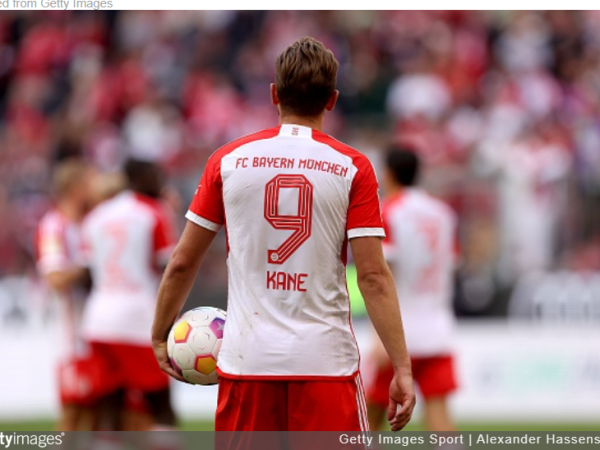After two successful years with Red Bull Salzburg, German coach Marco Rose made a return to his home country to take on the role as Borussia Monchgengladbach manager for the start of the 2019-20 season. Rose has continued his success with Gladbach so far since taking charge and has only enhanced his reputation as a manager, with 54% of his matches won and his team well within the title race for the first time in years. Under Dieter Hecking, Gladbach had a win percentage of 43%, and played primarily in a 4-4-2 Diamond or 4-3-1-2 shape. Rose has since changed Gladbach’s formation to primarily a 4-2-3-1, although has remained tactically flexible to at times deploy back-three formations and the 4-4-2 Diamond / 4-3-1-2 that he deployed at Salzburg. Here is a tactical analysis of Borussia Monchengladbach under Marco Rose.
Be sure to check out our latest Marco Rose analysis for the 2020-21 season.
SYSTEM OF PLAY: 4-2-3-1

Although chopping and changing his formation around frequently, Marco Rose has set his side up most often in a 4-2-3-1 formation. Like most 4-2-3-1 systems, Rose urges his fullbacks to advance with the play and become crucial focal points in attack. Luckily Rose has two fantastic players for the role in Stefan Lainer and Oscar Wendt. Conveniently, Lainer was a key figurehead of Salzburg’s lineup throughout Rose’s time at the Austrian club and the player and manager have a great understanding.
Rose has not been afraid to change his personnel, however a few key figures have been un-droppable from the side this season. Goalkeeper Yann Sommer is one of only two players to play all 25 matches this season. The other happens to be rising star Marcus Thuram, who has firmly established himself in Rose’s side in his first season with the club. Thuram has proven very capable of playing up front alongside Alassane Plea as part of a front two, or as the left winger cutting onto his right foot. The Frenchman impressed last season in Ligue 1 with Guingamp, scoring 9 goals with 1 assist in 32 matches. This season his assist totals have remarkably improved, adding 8 assists onto his 6 goals so far in 25 Bundesliga matches.
Embed from Getty ImagesAt the back, Matthias Ginter and Nico Elvedi have formed one of the most formidable centre-back partnerships in the league, while Austrian international Stefan Lainer has also been a key part of the back-four. Oscar Wendt has been the most frequently used left-back, while the midfield two pairing of Denis Zakaria and Christoph Kramer have formed a growing understanding between them. In the number 10 position, Florian Neuhaus and Laszlo Benes have battled for a spot in the lineup. Benes has been particularly impressive given that he only played 1 Bundesliga match last term under Dieter Hecking and is now a regular competitor in Marco Rose’s side.
BUILD-UP
Embed from Getty ImagesMonchengladbach utilize their fullbacks heavily in the build-up, allowing them to be key cogs for forward passes and engaging the wingers. In moments where they struggle to go forward, they will frequently utilize Yann Sommer in goal in order to restart the build-up. Naturally, the centre-backs will get wide and a defensive midfielder, usually Denis Zakaria or Christoph Kramer, will drop in to form a diamond shape, aiding in the build-up. Rose’s men will also frequently set up in a 2-4-3-1 combination, with the fullbacks as part of the midfield line or sometimes even higher than the midfield two in order to create numerical superiority in wide areas and stretch the field. Die Borussen are particularly capable of going more direct into the wide areas, or working it through their combination play involving the centre-backs to the fullbacks to the wingers. At times this season, the movement of the fullbacks into wide areas has also pushed the wingers inside, particularly when using back-three systems like the 3-4-2-1.
The use of the fullbacks is also particularly important in stretching the opposition defense. If the opposition fullback decides to engage Wendt or Lainer higher up the pitch, they abandon a massive section of space that is occupied by up to three attacking players. If the fullbacks are able to gain traction higher up the pitch, they will often favour cut-back passes or low/short crosses, rather than a traditional looping cross into the box. Either one of their shapes, both of which involve a number 10, make cut-backs a very natural tactic to employ.
PRESSING FROM THE FRONT
Gladbach have continued the same pressing principles in the 4-2-3-1 formation as they had in their 4-4-2 diamond (4-3-1-2) last season under Hecking. The attacking midfielder, usually Florian Neuhaus or Laszlo Benes, and the striker work in tandem to force the opposition to go long or wide, with the wingers coming inverted to complete the diamond shape on the press. The pressing system utilized appears to be more man-oriented rather than space oriented. For example in moments where the opposition goalkeeper has the ball, the striker may press the keeper, the wingers may cover the centre-backs and the number 10 will cover the opposition’s defensive midfielder. But the press goes far beyond just the front four to include the midfield two and the fullbacks. The fullbacks will frequently line themselves up with the opposition fullbacks in order to eliminate the option for longer balls or forward passes in the wide areas, as the defensive midfielders will usually engage with opposition central midfielders.
Interestingly for Marco Rose, instead of forcing his opposition back toward their own goal or to the middle of the pitch, Monchengladbach have a strong desire to force their opposition into wide areas, where they are set up well to win back possession. Gladbach’s press is also particularly aggressive. Although they have kept the 6th most amount of possession in the league this season, they also have the third worst disciplinary record. This further suggests that when they lose the ball, they don’t like to lose it for long.
QUICKNESS IN TRANSITION
Embed from Getty ImagesMonchengladbach are also particularly quick in transitional moments. Immediately after winning the ball they like to go on the hunt right away, utilizing short vertical passes or a ball carrier to advance the ball forward. All of Borussia’s attacking players are very capable ball carriers and the team have attempted the fourth most amount dribbles per game in the Bundesliga this season. The interchange of movement of players like Plea, Herrmann and Thurman becomes particularly key in these moments of transition, as Plea can often be found out wide and Thuram through the middle. Their ability to combine in this manner causes chaos for the opposition. Opposition centre-backs may find themselves out wide and stretched in order to mark Plea, allowing Thuram space to roam in the middle. Players like Denis Zakaria and Christoph Kramer are also particularly adept at winning the ball back, aiding in this tactic.
Counter attacking is not necessarily a method of many goals for Die Borussen, it is however a pivotal element of their play in quickly opening up space for their forward players to express themselves in attacking areas.
CONCLUSION
Embed from Getty ImagesAlthough Borussia Monchengladbach have lost a bit of traction in the Bundesliga title race, Marco Rose’s team were at the top of the Bundesliga table for many matchdays this season. Marco Rose has set his team up in a very tactically flexible way and with a few new player additions, they could soon be on the path to truly challenging for the Bundesliga title. Their use of the fullbacks in the build-up and attack is a particularly key element to their play, while quick attacking transitions and an aggressive press to force the opposition into wide areas are also interesting elements that have helped Monchengladbach to achieve success under Marco Rose this season.
So there it is! A tactical analysis of Marco Rose’s 4-2-3-1 formation and tactics with Borussia Monchengladbach this season. Be sure to be check out more Tactical Analyses, and follow @mastermindsite on Twitter to share your thoughts on what team/manager you’d like to see next. Thanks for reading and see you soon!





Shame to see that Lars Stindl is left out of this. He is the club captain and such an important player in this system.
LikeLike